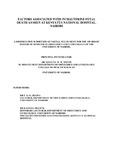Factors associated with intrauterine fetal death as seen at Kenyatta National Hospital, Nairobi
Abstract
Background: Fetal death in utero (stillbirth) is demise at 20 or more weeks of gestation and/or
weight 500gms and more. Worldwide, fetal death rates vary considerably depending on quality
of medical care available in the country in question. The local cut-off gestation is 28 weeks since
the chances of survival below this gestational age are very minimal. There are gender and racial
differences in perinatal mortality rates.
Fetal death at any point during gestation is a traumatic event not only to the family but also to the
caregiver. Although overall perinatal mortality rates have fallen considerably in the past several
decades in the developed world, it remains significantly high in the third world.
Despite improvement in antenatal and intrapartum care, stillbirth remains an important problem
in obstetrics. Although several conditions have been linked to stillbirth, it is difficult to define
theprecise aetiology in many cases. The proportion of stillbirths that have a diagnostic
explanation is higher in centres that conduct a defined systematic evaluation.
Objective: To determine factors associated with intrauterine fetal death at Kenyatta National
Hospital labor ward.
Study design: This is a cross-sectional descriptive study. Mothers with intrauterine fetal demise
wereidentified before, during labor and delivery. Their outcome was noted and the mothers
followed up prospectively until discharge.
Study site: Labor ward, maternity theatre, antenatal/postnatal wards of Kenyatta National
Hospital. This hospital is the national referral hospital and largest hospital in East and Central
Africawith a capacity of about 2,000 beds. In the year 2010, a total of 10744 deliveries occurred
atKNH, 557 (5.2%) of which were stillbirths.
Study population: A total of 90 women with intrauterine fetal death were enrolled and followed
upduring labor/delivery and postpartum period until the time of discharge.
9
Methods: A descriptive review of 90 cases of mothers with intrauterine fetal death between 1st
February and is" April was done. Structured questionnaires were used for collecting data of
maternal demographic characteristics, past medical and obstetric history, index pregnancy
antepartum, intrapartum and postpartum events, fetal, placental and cord assessment. Once
recruited the women were followed up until discharge. The placentae were submitted for
histopathological evaluation with the patients consent.
Results: 112 women had IUFD during the study period giving a prevalence of 5.1% and a
stillbirth rate of 51 per 1000 total births. 90 cases (the calculated sample size) were recruited,
theirdata collected and analysed.Hypertensive disorders were the commonest obstetric
complications in these mothers (26.7%), followed by antepartum hemorrhage (25.6%),
anemia(11.1%), PROM(11.1 %) and urinary tract infections(11.1 %). 10% of the mothers were
sero-reactive, 6.7% had congenital fetal anomalies, 2.2% had a febrile illness while 2.2% had
posttermgestation. Antepartum hemorrhage was the commonest cause of intrapartum deaths
(34.3%).
Majority(64.4%) of the placenta had detectable histopathological findings while 35.6% showed
normalplacenta, cord and membranes. The commonest pathological findings encountered were
infections (chorioamnionitis with or without funisitis)(21.1 %), acute ischaemic necrosis(20.0%),
placentalhemorrhage and hematoma(13.3%) and placental calcification (7.8%).
90% of the mothers had no postpartum complications during the time of follow-up. The
postpartum complications encountered were not directly related to the IUFD but to the obstetrics
andmedical co-morbidities that contributed to the fetal demise.
Conclusions: Hypertensive disorders and antepartum hemorrhage (APH) are the leading causes
ofintrauterine fetal demise at KNH. 65% of the placenta evaluated had detectable
histopathological findings. Women who delivered by caesarean section had more postpartum
complications and prolonged hospital stays.
Citation
Master of medicine in obstetrics and gynecologyPublisher
University Of Nairobi College of Health Sciences

